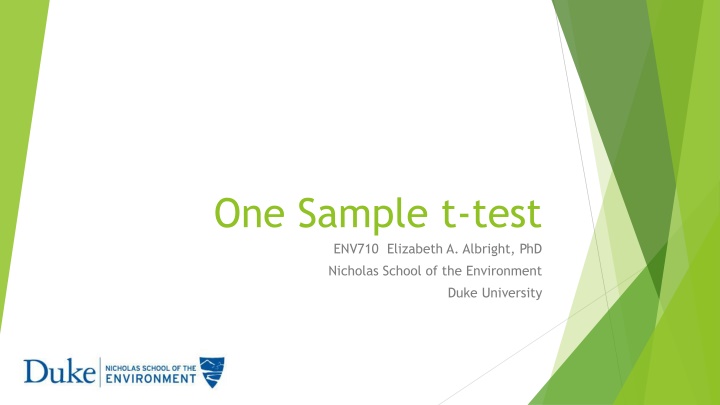
Conducting a One-Sample T-Test at Duke University
Learn about the general steps in conducting a comparison of means test, assumptions, and calculations involved in a one-sample t-test at Duke University to determine if MEM students walk more than 10 miles per week on average based on collected data.
Download Presentation

Please find below an Image/Link to download the presentation.
The content on the website is provided AS IS for your information and personal use only. It may not be sold, licensed, or shared on other websites without obtaining consent from the author. If you encounter any issues during the download, it is possible that the publisher has removed the file from their server.
You are allowed to download the files provided on this website for personal or commercial use, subject to the condition that they are used lawfully. All files are the property of their respective owners.
The content on the website is provided AS IS for your information and personal use only. It may not be sold, licensed, or shared on other websites without obtaining consent from the author.
E N D
Presentation Transcript
One Sample t-test ENV710 Elizabeth A. Albright, PhD Nicholas School of the Environment Duke University
General Steps in Conducting a Comparison of Means Test 1. Decide type of comparison of means test. (one sample, two sample, paired samples) 2. Decide whether a one- or two-sided test. 3. Examine the appropriateness of a comparison of means test (based on the assumptions)*** 4. Establish null and alternative hypotheses. 5. Decide whether a z-statistic or t-statistic is appropriate.
General Steps in Conducting a Comparison of Means Test 6. Calculate sample mean(s). 7. Calculate standard deviation of sample IF using a t-test. 8. Calculate standard error. 9. Calculate z-statistic or t-statistic. 10. Determine p-value from the test statistic using the appropriate z or t distribution. 11. Interpret the p-value in terms of the hypotheses established prior to the test.
One Sample t-test: Motivating Question Do Duke MEM students walk more than 10 miles a week on average? One-sided test Based on enrollment records, we randomly select 30 full-time, campus-based MEM students and give each a pedometer. MEMs wear pedometer and return after a week. Establish hypotheses Ho: walking 10 miles Ha: walking > 10 miles
Collect the Data Miles 30 12.27 7.09 2 30 Observations Mean Standard Deviation Minimum Maximum Miles Walked in One Week by MEM Students (n=30)
Assumptions Independent observations We randomly selected MEM students to help ensure independence. Normally distributed population of miles walked by MEM students Histogram suggests that the population may be roughly normally distributed This assumption becomes more problematic with outliers, heavy skewness and a small sample size.
t-statistic ? ?0 ?/ ? ? =
t-statistic ? =12.27 ?0 ?/ ?
t-statistic ? =12.27 10 ?/ ?
t-statistic ? =12.27 10 7.09/ ?
t-statistic ? =12.27 10 7.09/ 30
t-statistic t=1.75, 29 degrees of freedom p-value = 0.0903 Given that our null hypothesis is true (that Durham residents walk less or equal to than 10 miles/week on average), the probability of getting the results we got, or more extreme is 0.09.
How strong is the evidence? Ramsey and Schafer (2002). The Statistical Sleuth. A Course in Methods of Data Analysis, Second Edition, p. 47. 14
Conclusion Mildly suggestive, but inconclusive, evidence that Durham residents, on average, walk more than 10 miles a week.
